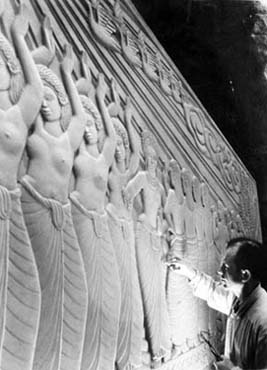Product Description
Walter Paul Suter (1901-?), American Art Deco glazed pottery sculpture 1929


WALTER PAUL SUTER USA
AMERICAN ENCAUSTING TILING CO. New York, NY
Art Deco Seated Female Figure with Draped Skirt and Holding an Art Deco Vase 1929
Hand-modeled and molded cream glazed earthenware figure with gold and silver details on a separate, but matching black glazed earthenware base.
Signed: SUTER ‘29 (under glaze on back right hand corner)
H: 13″ x D: 7 1/2″ x W: 9″
Price: $14,500
Walter Paul Suter was born in Basel, Switzerland in 1902 and studied there at the School of Fine and Applied Arts. He moved to the United States in 1924 and settled in New York. He was a member of the American Ceramic Society, as well as the Society of Swiss Painters, Sculptors & Architects. In 1932 Suter won first prize in the Robineau Member Exhibition in Syracuse. He was a member of the American Encaustic Tiling Company in NYC.
Walter Paul Suter (1901-?), American Art Deco glazed pottery sculpture 1929
KARL SCHMIDT (b. 1948) Vienna
HAGENAUER WERKSTÄTTE Vienna
Sculpture c. 1965
Handwrought sterling silver repoussé in the form of a nude with blowing hair
Marks: SCHMIDT WIEN MADE IN AUSTRIA 925 (silver standard) KS (artist initials)
For more information see: Metallkunst, Karl H. Bröhan (Berlin: Bröhan Museum, 1990) pp. 200-205; Werkstätte Hagenauer 1898-1956, (Vienna: Österreiches Museum für angewandte Kunst).
H: 17 1/4″ x W: 12″ x D: 2 3/4”
Price: $17,500
GIANNI L. CILFONE (1908-1990) USA
“After the Rain” 1928
Oil on canvas, contemporary quarter sawn oak pegged frame with yellow gold filet.
Signed: Cilfone, 1928 (lower left corner)
Marks: Illinois Academy of Fine Arts, Second Annual Exhibition 1928, Gianni L. Clifone, 905 South Ashland Boulevard, “After the Rain,” $500 (paper label).
Exhibited: Illinois Academy of Fine Arts, Second Annual Exhibition 1928, Art Institute of Chicago 1928
For more information see: Who Was Who in American Art (Madison, Conn.: Sound View Press, 1985) p. 115.
Canvas: H: 30” x W: 40”
Framed: H: 38” x W: 48”
Gianni Cilfone emigrated with his family from San Marco, Italy to Chicago at the age of five. After studying at the Art Institute of Chicago, Cilfone took lessons from Hugh Breckenridge and John F. Carlson. His consistently won many prizes from the Chicago Gallery Association throughout the 1930s and 40s. He exhibited at the Hoosier Salon between 1949 and 1958, at the North Shore Arts Association, at the Association of Chicago Painters and Sculptors, and at the Art Institute of Chicago in 1919 and 1928.
